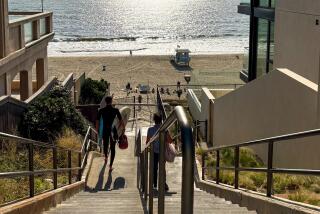Every weekend the neighborhood undergoes instant gentrification. : Collectibles: From Tawdry to Tantalizing in Canoga Park
Sherman Way in Canoga Park is as frumpy as any Valley boulevard, a seemingly endless strip of gas stations, apartment buildings and thrift shops that appear to have been Xeroxed instead of built.
It has neither a Bullock’s nor a Bloomingdale’s. Yet, on almost any weekend, Sherman Way between Owensmouth and Canoga is busy with upscale browsers.
OK. “Busy” is too strong a word.
Melrose Avenue it ain’t.
But, on Saturdays and Sundays, the seedy commercial center of Canoga Park attracts an unlikely number of BMW owners. During the week the avenue is lined with pickups and leprous Buicks, not infrequently with their hoods raised as emergency surgery is performed on their insides.
By 7 o’clock in the morning, dark-haired men seeking day labor are out on the sidewalks, waiting for someone who doesn’t ask a lot of questions to drive by and offer them a job.
But every weekend the neighborhood undergoes instant, albeit temporary, gentrification. The street is taken over by non-residents driving self-important cars. You see their vehicular jewels incongruously parked in front of the pawn shop and Batman a Go Go, which offers both “SANDWICHES” and “GIRLS” throughout the day.
Canoga Park clearly attracts whatever Yuppies are called these days. They leave the Westside and wealthier suburbs and come here to the urban boonies hoping to find a bargain in what local merchants have fancifully dubbed “Antique Row” in “Old Town Canoga Park.”
If Old Town implies vintage charm, or even its simulation in artificially weathered and wormholed plastic, you will be sorely disappointed in this particular Old Town, although you have to give the local merchants credit for resisting what must have been a powerful temptation to go all the way and spell that “Old Town e Canoga Park.” But, if you want to visit a lot of used-stuff stores without moving your car, this is the place to be.
“There were always thrift shops here, and there always will be,” said Alan Beutler, who has had a store on the street for 14 years. “It’s one step up to antiques.”
Beutler owns Old Friends, a shop specializing in what he calls “country American” furniture, mostly sturdy oak tables and other items that were originally sold through the Sears and Montgomery Ward catalogues of 50 or more years ago. Everything he sells has been refinished.
Beutler’s shop is a survivor of sorts, one of the declining number that handles only American furniture. Today most of the old pieces for sale were originally mass-produced overseas and sold through the British and European equivalents of the Sears catalogue. They are shipped in huge freight containers to Long Beach and wholesaled from there.
Beutler still gets his old-fashioned stock the old-fashioned way. He goes to the Midwest three or four times a year and buys rocking chairs and chifforobes. Beutler is also distinguished in that he knows, as many of his peers apparently do not, that collectibles isn’t spelled with an “a.”
The antique business isn’t what it was a few years ago, Beutler said. “It’s cyclic,” he said, and the recent trend has been decline. Oak furniture has dipped in popularity, but he has been able to hold his own because so many of the stores that once specialized in it have gone out of business.
The finest furniture was traditionally made of cherry, walnut, rosewood and other exotic woods, not of populist oak, Beutler noted. “But it’s still pretty adorable stuff,” he added, looking with real affection at the simple lines and golden finish of an oak dresser.
In terms of quality merchandise, Old Town’s 16 or so shops are a mixed bag, in Beutler’s view. “There’s three or four good stores and the rest of it is garage sale,” he said.
Indeed, you can spend an hour in one shop on the strip and not see a single thing you’d accept as a gift. It’s hard to believe that someone once went out and purchased, new, a pair of purple lamps in the shape of his and her exotic dancers. Why would anyone buy used novelty shot glasses?
But, in other shops, item after item reminds you just how therapeutic old things can be. Antiques, even collectibles, can provide instant roots, no small blessing in a society where even loved ones come and go. An apartment with an armoire is somehow less lonely than one without.
I grew up in a house full of antiques, but was long an adult before I realized that my mother, an orphan, had bought a history for herself when she bought those handsome old pieces. Only genes were handed down to her. So she had gone ahead and purchased the worldly legacy of her choice, no less valuable to her for being used.
All I know for certain about my actual forebears was that they ate a lot of potatoes and would have been lucky to afford oak.
In creating a heritage for us where none had been, my mother chose to trade up a social class or two.
She bought only cherry.


